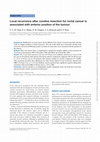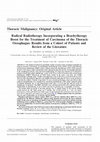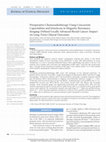Videos by Arthur Sun Myint
We previously reported the benefit of Contact X-ray Brachytherapy boost (CXB) in achieving a high... more We previously reported the benefit of Contact X-ray Brachytherapy boost (CXB) in achieving a higher clinical complete response (cCR) following partial response to external beam chemoradiotherapy (EBCRT). We now update our report on the organ preservation rate and long-term durability of the cCR in this cohort 3 views
Papers by Arthur Sun Myint

British Journal of Surgery, 2005
Background Mobilization of rectal cancer can be difficult if the tumour is located anteriorly and... more Background Mobilization of rectal cancer can be difficult if the tumour is located anteriorly and may result in a higher incidence of local recurrence. The aim of this study was to determine whether local recurrence and survival following curative resection of rectal cancer were associated with the position of the tumour. Methods Data were drawn from a comprehensive, prospective hospital registry of all resections for rectal cancer from January 1990 to December 1998, with follow-up to December 2003. Results The 5-year local recurrence rate was 15·9 (95 per cent confidence interval (c.i.) 11·0 to 22·8) per cent in 176 patients with tumours that had an anterior component compared with 5·8 (95 per cent c.i. 2·8 to 11·9) per cent in 132 patients with tumours without an anterior component (P = 0·009). This association persisted after adjustment for other factors linked to local recurrence (hazard ratio (HR) 2·4 (95 per cent c.i. 1·1 to 5·4)). Similarly, anterior position had a significan...

Colorectal Disease
AimNonsurgical treatment with chemoradiotherapy for rectal cancer is gaining interest as it avoid... more AimNonsurgical treatment with chemoradiotherapy for rectal cancer is gaining interest as it avoids total mesorectal excision (TME) surgery and stoma. The OPERA trial aims to evaluate whether dose escalation with contact X‐ray brachytherapy (CXB) boost improves organ preservation compared to external beam radiotherapy (EBRT) boost. It has been suggested that dose escalation adversely affects surgical outcomes and therefore we report outcomes following TME in OPERA at 36 months.MethodsOPERA is a European multicentre phase 3 trial (NCT02505750) which randomises patients with cT2‐3a‐b, cN0‐1, M0 to EBCRT (45 Gy in 25 fractions over 5 weeks with oral capecitabine 825 mg/m2) followed by EBRT boost (9 Gy in 5 fractions over 5 days) versus EBCRT followed by CXB boost (90 Gy in 3 fractions over 4 weeks). Patients were assessed at 14, 20 and 24 weeks from the start of treatment. Watch and wait management was adopted for patients who achieved a clinical complete response (cCR) at 24 weeks foll...

Clinical Oncology, Apr 1, 2002
The optimal treatment for potentially curable carcinoma of the oesophagus unsuitable for surgical... more The optimal treatment for potentially curable carcinoma of the oesophagus unsuitable for surgical resection is unresolved. An intraluminal brachytherapy boost (ILBT) can be used following external beam radiotherapy (EBRT) with or without concurrent chemotherapy (CRT). ILBT increases the dose to the tumour volume substantially while reducing the lung dose but the corresponding high dose to the oesophageal wall may cause increased complications. We report the outcomes of 32 consecutive patients treated with radical radiotherapy. A dose of 45-55 Gy in 20-25 fractions with external beam radiotherapy (EBRT) followed by an ILBT boost. Earlier in the series a low dose rate (LDR) brachytherapy technique using 125 Iodine seeds delivering a dose of 20-22 Gy at 25-40 cGy/h was used. This was later superseded by high dose rate (HDR) treatments delivering 8.5-10 Gy in one fraction at 1 cm from the catheter. Patients of age below 76 years, of good performance status and with no other medical contraindication were considered for concurrent chemotherapy (CRT) using a planned regime of cisplatin (80 mg/m 2 day 1) and 5-flurouracil (1 g/m 2 days 1 to 4) in the first and last weeks of radiotherapy (13 patients). The EBRT and ILBT were well tolerated but 8/13 (62%) patients had dose modifications of chemotherapy in one or both cycles due to advanced age, co-morbidity or toxicity. The median follow-up period of surviving patients was 37 months (range 35-39) and the median overall survival for the whole group was 9 months. The overall survival at 1 year was 34.4% (17.6-51.2%), 15.6% (2.8-28.4%) at 2 and 3 years. Local recurrence-free survival at 1 year was 35.3% (15.9-54.7%) and 24.5% (8.3-44.6%) at 2 and 3 years (Fig. 2). Though symptom relief was good there were six cases of ulceration, six of stricture and two fistulae. Biological equivalent for tumour response (BED Gy 10) and late radiation effects (BED Gy 3) were calculated for the different radiotherapy regimens using equations derived from the linear quadratic model. In this series no advantage was found in terms of local control or survival for patients receiving radiotherapy doses resulting in a BED Gy 10 greater than 75% of the maximum. Similarly, no significant increase in complications was noted in those patients receiving doses resulting in a BED Gy 3 >75% of the maximum. The merits and hazards of the ILBT boost used in radical radiotherapy are discussed and the relevant literature reviewed.

Journal of Clinical Oncology, Mar 10, 2011
To assess long-term clinical outcomes of preoperative chemoradiotherapy of magnetic resonance ima... more To assess long-term clinical outcomes of preoperative chemoradiotherapy of magnetic resonance imaging (MRI)-defined locally advanced rectal adenocarcinoma using concurrent irinotecan and capecitabine. Patients and Methods One hundred ten patients without distant metastases entered this phase II trial North West/North Wales Clinical Oncology Group (NWCOG)-2 after MRI demonstration of tumor threatening (Յ 2 mm) or involving mesorectal fascia. Pelvic radiotherapy was given to 45 Gy in 25 fractions over 5 weeks with concurrent oral capecitabine at 650 mg/m 2 twice per day continuously days 1 through 35 and intravenous irinotecan at 60 mg/m 2 once weekly weeks 1 to 4. One hundred seven patients subsequently underwent surgical resection. Results Comparing prechemoradiotherapy MRI scans with histology of the resected specimen, 72 patients (67%) had their initial MRI T stage downstaged and 64 patients (80%) had their N stage downstaged. Twenty-four patients (22%) demonstrated a pathologic complete response (ypCR) and 98 patients (92%) demonstrated a negative circumferential resection margin (Ͼ 1 mm). Three-year local recurrence-free survival was 96.9%, metastasis-free survival (MFS) was 71.1%, disease-free survival was (DFS) 63.5%, and overall survival (OS) was 88.2%. By univariate analysis, lower histologic stage was significantly associated with superior MFS, DFS, and OS, whether expressed as ypT0-2 versus ypT3-4, ypN0 versus ypN1-2, or ypCR/microfoci (near-ypCR) versus other patients. By multivariate analysis both ypN stage (P ϭ .048) and ypCR/microfoci/ others (P ϭ .013) remained significant predictors of DFS but only ypCR/microfoci/others for OS (P ϭ .005) with no difference in outcome between ypCR compared to microfoci. Conclusion This regimen demonstrates high response rates and promising long-term survival. Downstaging to ypCR/microfoci may be a useful short-term surrogate for long-term survival but needs validation in large phase III trials powered for survival outcomes.
Springer eBooks, Oct 1, 2015
Colorectal Disease, Jan 20, 2011

Ejso, Nov 1, 2018
People interested in the research are advised to contact the author for the final version of the ... more People interested in the research are advised to contact the author for the final version of the publication, or visit the DOI to the publisher's website. • The final author version and the galley proof are versions of the publication after peer review. • The final published version features the final layout of the paper including the volume, issue and page numbers. Link to publication General rights Copyright and moral rights for the publications made accessible in the public portal are retained by the authors and/or other copyright owners and it is a condition of accessing publications that users recognise and abide by the legal requirements associated with these rights. • Users may download and print one copy of any publication from the public portal for the purpose of private study or research. • You may not further distribute the material or use it for any profit-making activity or commercial gain • You may freely distribute the URL identifying the publication in the public portal. If the publication is distributed under the terms of Article 25fa of the Dutch Copyright Act, indicated by the "Taverne" license above, please follow below link for the End User Agreement:
Radiotherapy and Oncology, May 1, 2023
Radiotherapy and Oncology, May 1, 2023
Hospital Medicine, Jun 1, 2003
Over the past decade, chemotherapy has been increasingly used in patients with colorectal cancer.... more Over the past decade, chemotherapy has been increasingly used in patients with colorectal cancer. The impact of treatment on the patient can be substantial both physically and psychologically. The colorectal nurse specialist plays an important role in providing support and advice for the patient and their families, and also has a valuable role in coordinating the multidisciplinary team.
Clinical Oncology, Nov 1, 2007
PubMed, Jun 1, 2014
The concepts for management of rectal cancer have changed drastically over the past few years. Th... more The concepts for management of rectal cancer have changed drastically over the past few years. Through national bowel cancer screening programmes in the Western countries and the increasing use of endoscopic procedures as diagnostic tool, there is increase in detection of rectal cancer in early stages. There is increase in ageing population worldwide but more so in Western countries. In addition, there is realisation of harm from extirpative surgical procedures which are directed towards managing advanced rectal cancer in the past. Increase in cost of health care burden has also led the investigators to seek alternative treatment options which are effective, safe and cost effective. There are several modern radiation techniques which fits this bill and we need to be aware of newer novel radiation techniques to fulfil this gap.
Colorectal Disease, Feb 27, 2019

Journal of Clinical Oncology, May 20, 2020
4101 Background: Phase II studies reported high pathological complete response (pCR) rates and ac... more 4101 Background: Phase II studies reported high pathological complete response (pCR) rates and acceptable toxicity using irinotecan and fluoropyrimidine chemoradiation in LARC (ISRCTN:09351447). Methods: This phase III, multicentre, open-label trial funded by Cancer Research UK, randomly assigned (1:1) patients with MRI defined LARC threatening or involving resection margins without metastases, to pre-operative radiotherapy (RT) 45Gy/25 fractions combined with either capecitabine 900mg/m2(CRT) or 650 mg/m2 bd weekdays with Irinotecan iv once-weekly 60mg/m2 weeks 1-4 (IrCRT). The primary endpoint is disease-free survival (DFS). Secondary endpoints include treatment compliance, safety and pCR. Results: 75 UK sites randomised 564 eligible patients from Oct/11 to July/18; 284 to CRT and 280 to IrCRT. 370 (66%) male; median age 61 years (range:29-83). Staging in both arms was similar: mrT3 (432/564(77%), mrT4 (89/564(16%); mrCRM involved (275/564(49%); threatened ≤1mm (215/564(38%). Compared with CRT, IrCRT patients were less likely to receive 45Gy RT (207/276(75%) vs 251/283(89%), p < 0.001) or receive ≥90% capecitabine dose in 188/276(68%) vs 253/283(89.4%)p < 0.001). A total of 204/276(74%) received ≥90% irinotecan dose. The grade 3-4 gastrointestinal adverse event rate was 21%(58/276) with IrCRT and 12%(34/283) with CRT (p = 0.004). Patients receiving IrCRT had significantly more diarrhoea 38/276(13.8%) vs 10/283(3.5%)p < 0.001) and neutropenia 27/276(9.8%) vs 3/283 (1.1%) p < 0.001). Two CRT and three IrCRT patients experienced a treatment related death. 237/276(86%) IrCRT and 241/283(85%) CRT patients had surgery. The median time from end of RT to surgery(10.6 weeks), the surgical procedure APE 262/478(55%), AR 189/478(40%), Hartmann’s 10/478(2%); and the surgical complications(any event) 38%(181/478) were similar in both arms. The pCR rate is available in > 95% patients and is 20.2%(46/228) for IrCRTvs.17.4%(40/230) for CRT (p = 0.45), A > 84% CRM-ve resection rate is similar in both arms. Conclusions: For patients with MRI defined high risk LARC low rates of CRM involvement were observed in both arms reflecting high quality multidisciplinary care. The addition of irinotecan did not significantly improve the pCR rate, was associated with a decrease in the RT and capecitabine compliance and a higher rate of adverse events. Surgical procedure or complications were unaffected. Longer follow-up is required to assess DFS and translational data. Clinical trial information: 09351447 .
European Journal of Gastroenterology & Hepatology, Apr 1, 2000
Journal of The American Academy of Dermatology, Apr 1, 2003
BMJ, Jan 10, 2020
John Edgar Dalby attended Manchester Grammar School and studied medicine at Trinity Hall, Cambrid... more John Edgar Dalby attended Manchester Grammar School and studied medicine at Trinity Hall, Cambridge. He served in the Royal Army Medical Corps for two years after the war. Later, he started training in radiotherapy at the Christie Hospital in Manchester under the world renowned radiotherapist Professor Ralston Paterson, in the 1950s. External beam radiotherapy was in its infancy, with only orthovoltage (low energy) machines available to treat many advanced cancers. Owing to its low energy, the penetration of radiation was poor, and most of the time it was not effective. Brachytherapy …
InTech eBooks, Oct 10, 2011








Uploads
Videos by Arthur Sun Myint
Papers by Arthur Sun Myint